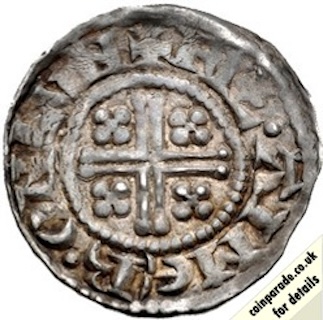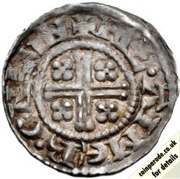
 The 1180 Penny - Henry II Short Cross Type
The 1180 Penny - Henry II Short Cross TypeShort Cross Penny of Henry II, Silver, struck around 1180 at London. Moneyer was Fil Aimer. Short Cross class 1a3. North 962. SCBC: 1343.
The moneyer Philip Aimer was an important figure in the introduction of the short cross coinage in 1180, and came to England from France. However, there was some improprieties going on concerning an exchanging offence, which resulted in some moneyers being removed and fined, and one was executed for fraud; Aimer was fired by the mint in May 1181.
The Obverse shows a crowned bust facing. Small face round 'E' and 'C' (class 1a). Legend is "HENRICVS · R ?X".
 The Reverse shows the voided short cross pommée in the centre of the coin. Quatrefoils in angles. Legend is "+ FIL · ΛIM?R · ON LVN"
The Reverse shows the voided short cross pommée in the centre of the coin. Quatrefoils in angles. Legend is "+ FIL · ΛIM?R · ON LVN"Image credit: CNG Coins
Mintage: Not known
Minted at Provincial mints
More information (monarch, year, mint, country, category) can be found below coin listings.
Below are some coins currently being offered on eBay. As an eBay Partner, We may be compensated if you make a purchase.
List items on:
List items on:
Henry II (1154-1189)
Classification: King of England, House of PlantagenetHenry II was born on 5 March 1133 at Le Mans, France, to the Empress Matilda and Geoffrey Plantagenet, Count of Anjou. In 1152, he married Eleanor of Aquitaine, the former Queen of France as the wife of King Louis VII. He became King of England on 19 December 1154.
Henry was not a popular King, and the murder of Thomas Becket and other incidents made him even less liked. He claimed the throne that Stephen of Blois had occupied and then fell out with several of his eight sons, including Richard. Henry II wanted his son John to be King, but after conflict Henry, already seriously ill, died on 6 July 1189 in France and the next monarch was Richard I.
The Coins of Henry II
From 1158-1180 was the "Cross-and-Crosslets", better know as "Tealby" coinage after a huge hoard of over 600 coins were found in Tealby, Lincolnshire in 1807. Twenty-nine mints were started to create the new coins, and about twelve remained after completion.
From 1180-1189 was the "Short Cross" coinage. It's important in some ways as these coins were used during the reign of Henry II, Richard, Stephen and grandson Henry III. No English coins carry the name Richard or John. All the coins carry the name "HENRICVS", but there's a lot of mints and moneyers involved during these reigns.
Category: Penny
The Penny is one of the most famous British coins. The coin itself has been around since 600AD and at various times has been struck in silver, copper and bronze. Originally split into halfpennies and farthing, it is now itself the least denomination coin currently in circulation. Made from copper (actually copper plated steel). Originally there were 12 pennies in one shilling and 240 pennies in £1; since decimalisation in 1971 there are 100 new pence in one pound.
Composition: Early pennies were Silver, then Copper, Bronze and Copper coated steel.
Which Mint: Provincial mints
Not all mints are located in a single place. From the Roman days through to the middle ages it was easier to have local moneyers (trusted people who were allowed to mint coins) rather than make the coins centrally and then have the security and logistics problem of distribution.There were often dozens of mints, sometimes all making the same coin. The variations and mintmarks are exciting for numismatists, although sometimes it takes an expert to analyse them.
Most English Provincial Mints began to close after 1279 when the Royal Mint opened The Tower Mint (called so as it was housed at the Tower of London), although some continued working for much longer. The central mint gave the King and the Master of the Royal Mint much more control over the production and quality of English coinage.
Country of Origin: United Kingdom
The United Kingdom (UK) is the Union of England, Scotland, Wales and Northern Ireland. It is often refered to as Great Britain (GBR). It has a long, rich history. The orignal coinage was Pounds, Shillings and Pence but since decimalisation on 15 February 1971, it is £1 = 100p, that is One Pound = 100 pence. The coinage of the UK is also a long history, the Royal Mint being established as long ago as 886AD when coins were hammered. Today there is perhaps 30 billion coins in circulation, and many (numismatic) collectors coins and sets are issued frequently in gold, silver and other metals.








